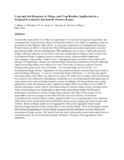| dc.contributor.author | J, Kihara | |
| dc.contributor.author | J, Mukalama | |
| dc.contributor.author | F. O, Ayuke | |
| dc.contributor.author | S., Njoroge | |
| dc.contributor.author | B, Waswa | |
| dc.contributor.author | J, Okeyo | |
| dc.date.accessioned | 2013-02-26T07:38:33Z | |
| dc.date.issued | 2012 | |
| dc.identifier.citation | A. Bationo et al. (eds.), Lessons learned from Long-term Soil Fertility Management Experiments in Africa, | en |
| dc.identifier.uri | http://erepository.uonbi.ac.ke:8080/xmlui/handle/123456789/11306 | |
| dc.description.abstract | Conservation agriculture (CA) offers an opportunity to reverse prevailing land degradation and consequent loss of productivity often occasioned by intensive soil tillage in cropping systems in most parts of sub-Saharan Africa (SSA). A long term experiment was established in Nyabeda Western Kenya in 2003 to evaluate the effect of tillage and crop residue application on maize and soybean yields, and on soil properties. The experiment was set up as a split-split-split plot design with four replicates and involved a factorial combination of tillage system (reduced and conventional tillage), cropping system (continuous cereal, soybean-maize rotation and intercropping), crop residue – maize stover – management (plus and minus crop residue) and nitrogen (N) application. Results showed that tillage infl uenced performance of maize although signifi cant tillage effects were observed in only 5 out of the 15 seasons analyzed. Overall average maize grain yields were 2.9 ton ha −1 in reduced tillage and 3.6 ton ha −1 in conventional tillage systems. Application of crop residue increased seasonal maize grain yield in reduced tillage (340 kg ha −1 ) and in conventional tillage (240 kg ha −1 ), but the only signifi cant crop residue (CR) effect was observed in season 10. Differences in maize yields between the two systems were attributed to phosphorus availability as it was demonstrated that application of crop residue in the reduced tillage resulted in better availability of P than without crop residue application. Under the rotation system, signifi cant tillage effects were observed in 6 of the 15 seasons with greater maize yield in conventional than in reduced tillage system. Soybean yields under reduced tillage were comparable to those from conventional tillage with the good performance of soybean in reduced tillage being related to the effect of its canopy on soil evaporation, and or to changes in microbial diversity and soil structure. For both the conventional and reduced tillage systems, legume
benefi ts on succeeding maize were observed with similar maize yields being observed
between maize monocropping and maize rotated with soybean. Reduced tillage improved soil aggregation with greater aggregate mean weight diameters being observed in this system than in conventional tillage. Tests for biological activity showed that the application of crop residue increased termite abundance in both reduced and conventional tillage systems. The results from this study indicate the conservation agriculture on soil productivity.
Keywords Reduced tillage • Rotation • Soybean • Soil aggregation • Soil organisms | en |
| dc.language.iso | en | en |
| dc.publisher | Springer Science+Business Media | en |
| dc.subject | Reduced tillage | en |
| dc.subject | Rotation | en |
| dc.subject | Soybean | en |
| dc.subject | Soil aggregation | en |
| dc.subject | Soil organisms | en |
| dc.title | Crop and Soil Response to Tillage and Crop Residue Application in a Tropical Ferralsol in Sub-humid Western Kenya | en |
| dc.type | Book chapter | en |
| local.publisher | Tropical Soil Biology and Fertility (TSBF), Institute of CIAT, c/o ICRAF , Nairobi , Kenya | en |
| local.publisher | Department Of Land Resource Management and Agricultural Technology, University of Nairobi | en |
| local.publisher | Alliance for a Green Revolution in Africa (AGRA) , Accra , Ghana | en |

